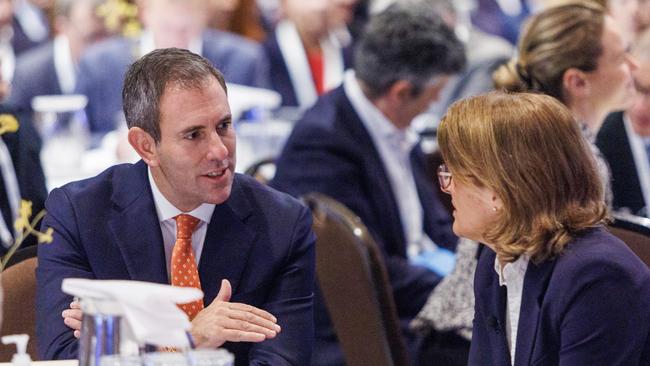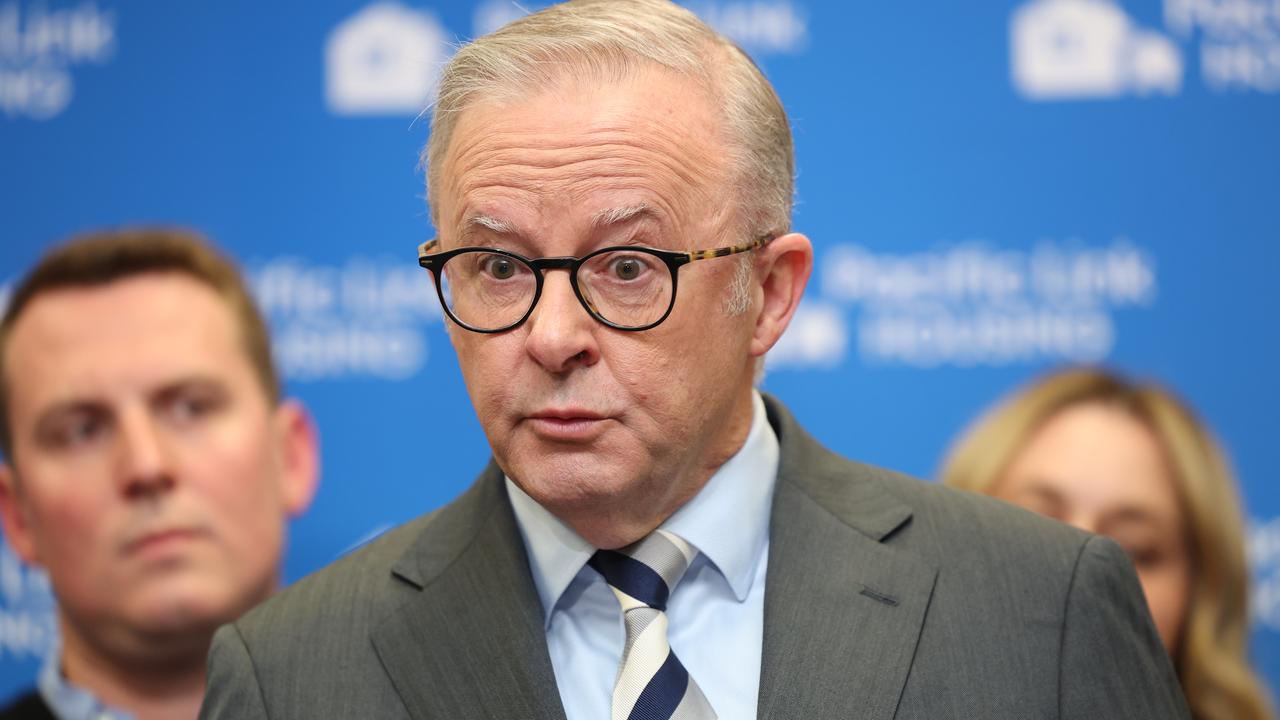Flush with cash Canberra tells Labor states to tighten belts ahead of budget update
Jim Chalmers may be sitting on a second budget surplus but he’s not willing to splash out the cash at a time of high inflation.

Jim Chalmers is set to rebuff a concerted campaign from Labor state treasurers to prop up their ailing finances, amid a personal income and sales tax bonanza that economists estimate is on track to deliver Canberra a $10bn budget surplus this year.
Ahead of this month’s mid-year fiscal update, state and territory custodians are seeking an extension of a temporary funding guarantee of the GST distribution, while the Albanese government also fends off calls for more cost-of-living relief for families and a push by Labor MPs to rethink the stage three tax cuts due next July.
In Brisbane on Friday, the Treasurer will meet his state and territory counterparts, who will demand an extension of a 2018 “no worse off” guarantee of the GST carve-up, due to expire in 2027, granted by the previous Coalition government that provides an extra $5bn a year to the provinces.
State officials are accusing Canberra of serial “cost-shifting” on housing, infrastructure and health services and fear a looming “fiscal cliff” will imperil ongoing funding for social services.
With debt burdens rising in coming years, particularly in Victoria and NSW, state officials argue the federal government is on track to book a second straight budget surplus because of elevated export prices and a surging tax take.
On the eve of the meeting of the Council on Federal Financial Relations, Dr Chalmers played down the rapid improvement in the federal budget, as well as any scope for new family assistance beyond the $23bn the government had announced.
The Treasurer said budget pressures “are on all of us, not just some of us”, and that “state governments have done quite well out of the Albanese Government” including for housing and skills.
“The GST deal that was struck by Scott Morrison a few years ago has blown out in costs by $27bn and so that’s not irrelevant to the conversation either,” Dr Chalmers said of an arrangement that must be reviewed by the Productivity Commission before the end of 2026.
PC chairwoman Danielle Wood has called the special deal, which also guarantees Western Australia per capita GST revenue of 70 cents in the dollar, bad policy and “now untenable” given the state’s surging mining royalties and the parlous condition of budgets in other jurisdictions.
“I genuinely want to work closely with my state and territory counterparts,” Dr Chalmers said.
“I understand the pressures on their budgets, I’m asking them to understand the pressures on the commonwealth budget as well.”

In May, Treasury estimated an underlying cash deficit of $13.9bn for 2023-24, but according to the Department of Finance the budget is $9bn in better shape over the four months to October.
Private sector budget watchers are forecasting a surplus of between $10-$20bn this financial year, as Canberra’s tax take from workers jumped by 18 per cent in the four months to the end of October, compared with a year earlier, while imposts on spending, such as the GST, were up by 6 per cent.
Independent economist Chris Richardson said “the budget is currently getting better solely because the government’s share of national income is outpacing Treasury’s expectations for that share”.
“Government surpluses are still outperforming, but that’s now increasingly coming at the cost of deeper underperformance in family finances,” Mr Richardson said.
Commonwealth Bank chief economist Stephen Halmarick this week estimated the Mid-Year Economic and Fiscal Outlook would show a $20bn underlying cash surplus for 2023-24, from an economy “driven by both higher commodity prices and a stronger population growth rate”.
But Dr Chalmers said “people shouldn’t anticipate that we will print a second surplus” in the mid-year budget update.
“They should expect to see a really substantial improvement in the bottom line but we’re not yet forecasting that second surplus,” he told ABC’s RN Breakfast.
Mr Richardson said the budget position was currently “as good as it gets”, with the 12-month cumulative surplus stuck at around $26bn, noting Treasury’s forecasts for iron ore and coal prices were likely to be much more conservative than his own.
While the Rich Insight principal calculates deficits for each of the final three years of the current four-year budget period, those shortfalls will be at least $20bn better a year than Treasury estimated in May.
As the buying power of household incomes are eroded by higher inflation, taxes and mortgage interest charges, on Thursday the Treasurer and Finance Minister Katy Gallagher met with backbench colleagues to discuss budget aid for families,
Dr Chalmers said the defining feature of the MYEFO, to be released in the week after next, “will be responsible economic management to continue to put downward pressure on inflation”.
“People shouldn’t expect a heap of new initiatives like we saw in May and in the October budget before that,” he said.
Mr Richardson noted a sharp fall in material living standards over the past two years and said while providing fresh assistance to families might be good politics, it would be bad economics.
“Extra money going into an economy still struggling with an inflation problem hurts as much as it helps,” he said.
“If the government gives you money to help, you’ll spend it – that’s the whole point. That extra spending will make prices go up. And, worse still, prices could go up by enough to push the Reserve Bank into raising interest rates again.
“That means efforts to help fight a cost-of-living crisis can actually make it worse rather than better.”
In its latest Economic Outlook, the OECD said Australia’s “underlying budget deficit is projected to narrow in 2023, largely owing to a spike in tax receipts from businesses and households”.
“Fiscal policy is assumed to have a slightly contractionary influence on economic growth in 2024 and 2025,” the OECD report said.
“Further fiscal reforms are needed to improve the sustainability of the public finances given that costs related to population ageing and the climate transition will intensify.”




To join the conversation, please log in. Don't have an account? Register
Join the conversation, you are commenting as Logout